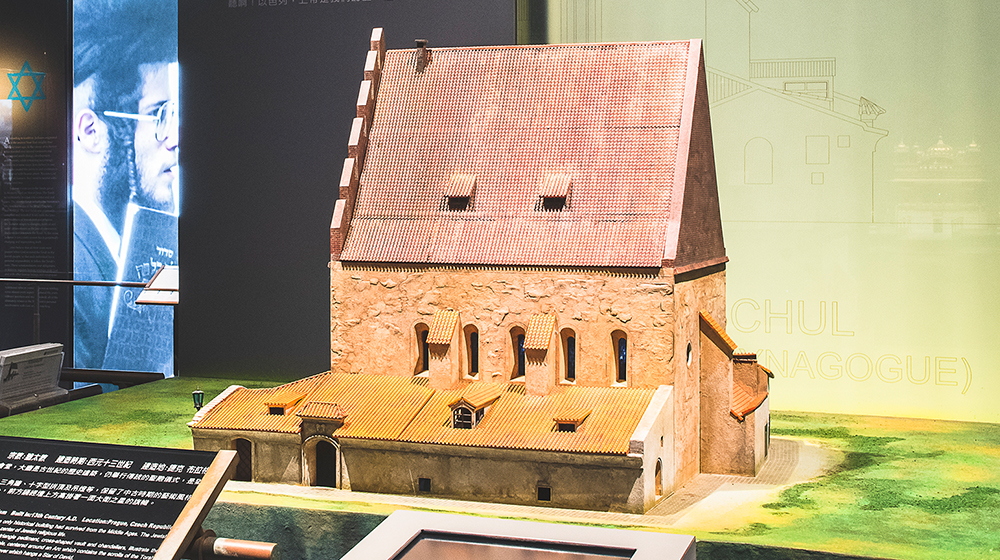Religious architecture is undoubtedly a symbolic cultural attraction of each region, and the aesthetics of architecture, craftsmanship, and the manifestation of the times and regional culture are all fascinating. It is a place that unites people across generations and regions, and a sanctuary where people genuinely demonstrate the value of goodness through beauty. In this central area of the exhibition hall, Mr. Han Baode, the ex-director of the museum, and sculptor Mr. Lin Jiancheng collaborated in 2003 to select religious buildings with historical value and architectural characteristics and to create high-precision architectural models at a scale of one to thirty or one to fifty. Through these exquisite large-scale models, we are able to see the layout and details of the buildings out of the perspective of admiration. Besides, the mini-cameras inside the models project the effects of the building's interior onto the screen, simulating the perspective and senses of people entering the building, allowing the audience to walk into these sacred structures as if they were really there!

Dome of the Rock
Religion: Islam
Period of construction: 7th century C.E.
Location: Jerusalem
Model Scale: 1:50
Located in the Old City of Jerusalem, the Dome of the Rock is also known as Qubbat aṣ-Ṣakhra. The golden dome, with its crescent-shaped finial, is an octagonal building with marble walls inlaid with colorful mosaic tiles and stained glass, decorated with Qur'anic verses. Its interior columns and arched doors are surrounding a white stone in the center of the structure. It is the rock on which Prophet Muhammad ascended to heavens in his night journey (al-Isra wa al-Miraj).
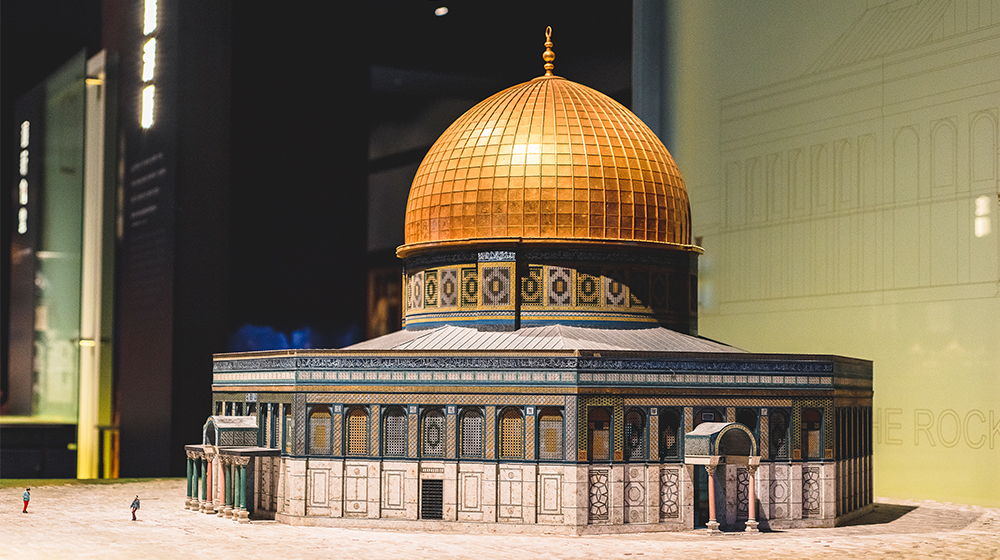
Luce Chapel
Religion: Christianity
Period of Construction: 20th century C.E.
Location: Taichung, Taiwan
Model Scale: 1:30
Luce Chapel was built as a memorial to an American missionary Dr. Henry W. Luce (1847-1941). It is located in the campus center of Tunghai University. The church is not only the center of the university's faith activities, but also a wellknown architectural masterpiece due to its innovative structure and planning. The exterior walls of the church are composed by four separate hyperbolic surfaces, and the roof, walls and beams are united, making the structure of the building light and smooth. The interior space holds great simplicity, divided into an altar and seats. The golden cross above the altar and the natural lights reflect on each other, and the lattice beams and glass windows extending upward, bringing great sense of sacredness.

Golden Temple
Religion: Sikhism
Period of construction: 16th to 17th century C.E.
Location: Amritsar, India
Model Scale: 1:30
The Golden Temple, the most important political and religious center of Sikhism, was built by Guru Arjan and completed in 1601. It was rebuilt in the early 19th century by Maharaja Ranjit Singh with marble and gold, and the dome and walls are covered with gold and led to the name Golden Temple.
In Punjabi, the Golden Temple is called the "abode of the gods". The temple has a main hall and rooms for worshipping and resting, and the arches and walls are decorated with traditional carvings and religious texts. The Golden Temple is in the center of Amritsar Lake, which is known as the "Lake of Immortality", and a causeway connects the temple with the marble walkways surround the lake.
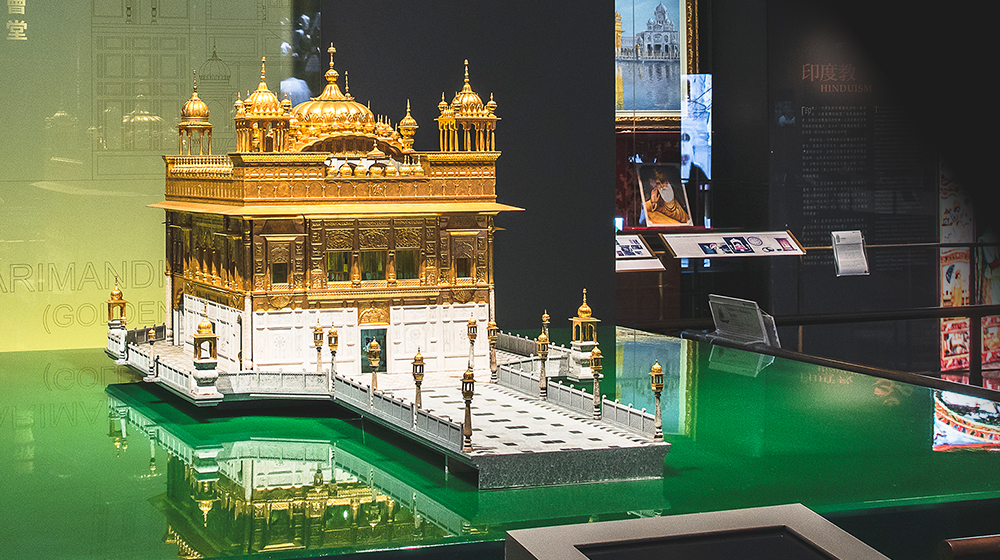
Ise Grand Shrine
Religion: Shinto
Period of Construction: 2th century C.E.
Location: Mie Prefecture, Japan
Model Scale: 1:30
Ise Jingu is located in the vast forest southwest of Ise Bay and consists of more than a hundred shrines, led by the Imperial Grand Shrine(Naiku), which is dedicated to Amaterasu Omikami. The original form of Ise Jingu was developed from a storehouse where sacred treasures were kept. The building is made of rustic logs, with a hollow floor and surrounded by a wooden fence. The roof is shaped like a mountain and covered with thatched grass, and there are dazzling golden decorations on the roof to show sacredness and beauty.
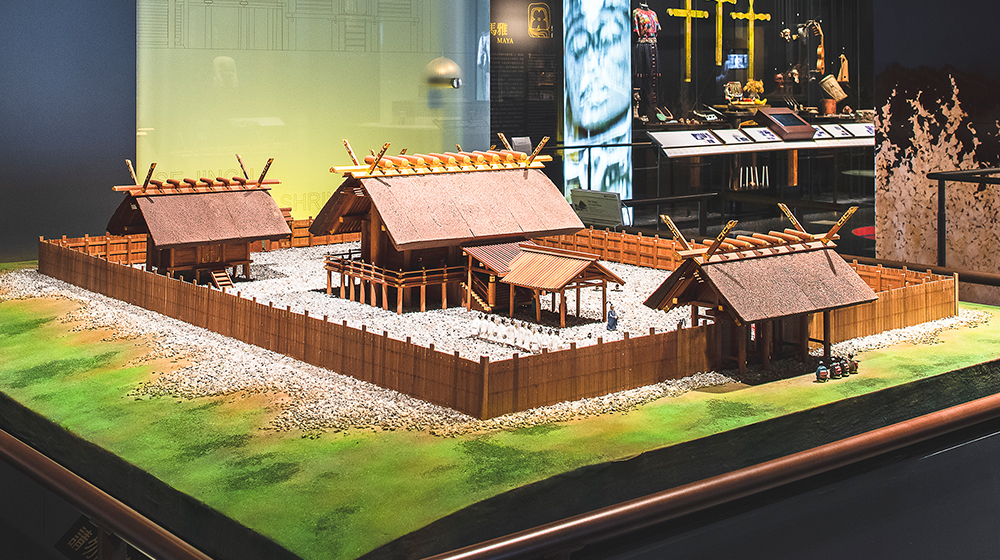
Kandariya Mahadeva Temple
Religion: Hinduism
Period of Construction: 10th to 11th century C.E.
Location: Khajuraho, India
Model Scale: 1:30
The temples of Khajuraho were important constructions during the Chandela dynasty in north central India, and there were 85 temples in their heyday. Among them, the Kandariya Mahadeva Temple in the west temple complex is a great representative of buildings of that time. The Kandria Mahadeva Temple was built on a pedestal platform with multiple levels, the outer walls of which are covered with carvings of beasts, flying celestial beings, and delicate and vivid statues of lovers having intercourse. The walls of the pedestal are decorated with intricate lines and floral motifs, interspersed with lotus, semicircles, and jug-shaped decorative carvings.
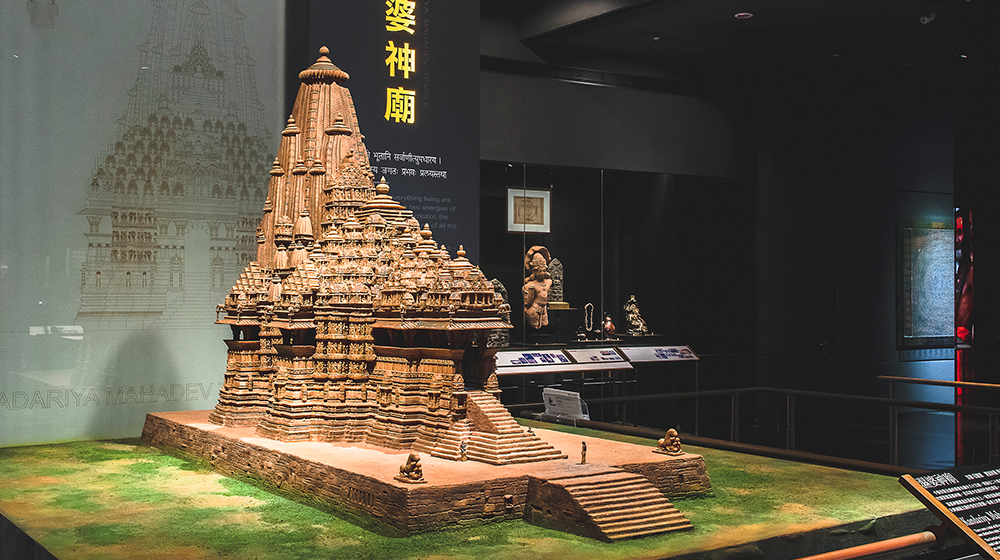
Chartres Cathedral
Religion: Christianity
Period of Construction: 12th to 13th century C.E.
Location: Chartres, France
Model Scale: 1:50
Chartres Cathedral is an outstanding example of French Gothic architecture. The interior of the cathedral is composed of stone columns and vaults, while the exterior is designed with flying buttresses for weight-bearing, making the cathedral looks elegant. The cathedral is in the shape of a traditional Latin cross, and the floor of the nave is decorated with a labyrinth for prayers. The cathedral's biblical reliefs and statues are scattered throughout the church, and the magnificent stained glass, with its pictorial narrative of religious stories, presents a unique mystical beauty.
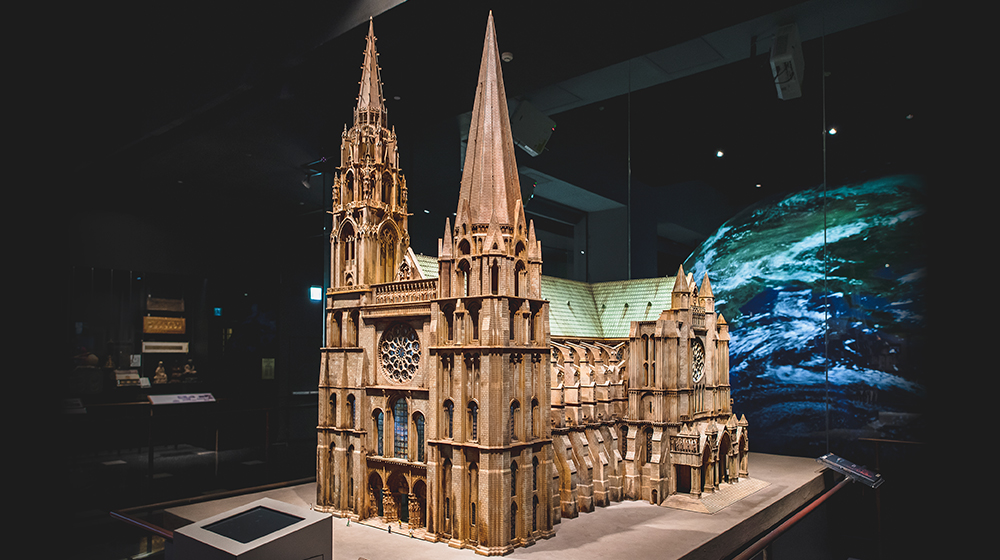
Buddha's Light Temple
Religion: Buddhism
Period of Construction: 9th Century C.E.
Location: Shanxi Province, China
Model Scale: 1:30
Located in Wutai County, Shanxi Province, Foguang Temple is a three-part compound with more than 120 halls, chambers, buildings and pavilions. The main hall, also known as the Eastern Hall, with its majestic arch and staggered beams, is the most typical existing representative building of Tang Dynasty wooden-frame Buddhist temple architecture. The inner walls of the East Hall are painted with wall paintings of Luohan and Buddhist scriptures, and more than 200 statues of arhat from the Ming dynasty are listed on both sides and at the rear; the Buddha altar is decorated with many tall statues of the Buddha from the Tang dynasty. The hall has preserved the essence of architecture, sculpture and painting of the Tang Dynasty and has high historical and artistic value.
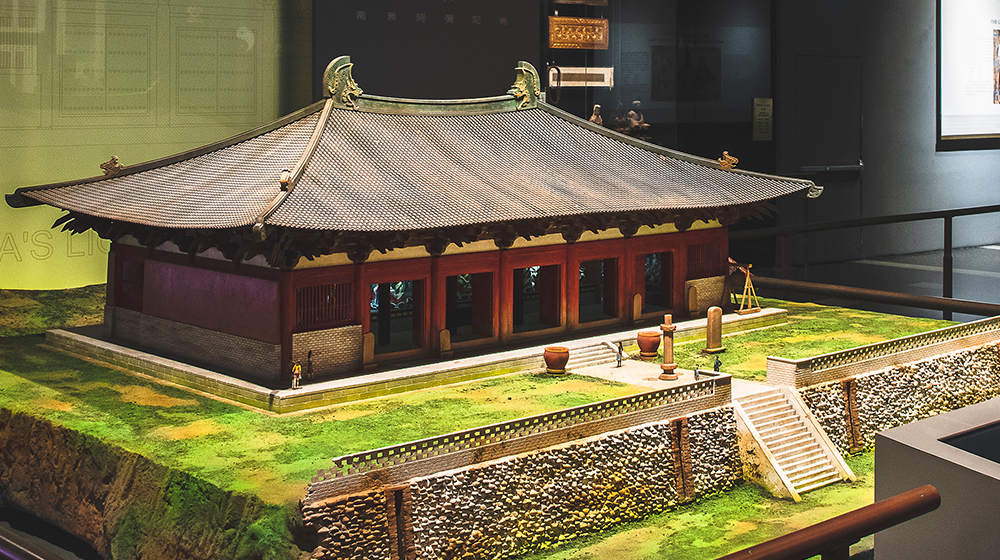
Borobudur
Religion: Buddhism
Period of Construction: 9th Century C.E.
Location: Java, Indonesia
Model Scale: 1:50
The name Borobudur literally means "stupas on a hill". Originally buried deep in volcanic dust, the magnificent structure was excavated in the 19th century when the Buddha statue on the ground was slightly exposed. Borobudur is a stone structure with a square exterior and a round interior, rising gradually from the bottom to the top, symbolizing the realm of Buddhahood, and looking from above like a standing mandala, which has a deep religious connotation. The sculptures of Borobudur are mainly Buddha sculptures and reliefs, and the Buddha statues are placed in the niche on each platform and in the stupa at the top, and the numerous wall reliefs are mostly based on the life of Buddha and the stories of Buddhist scriptures.
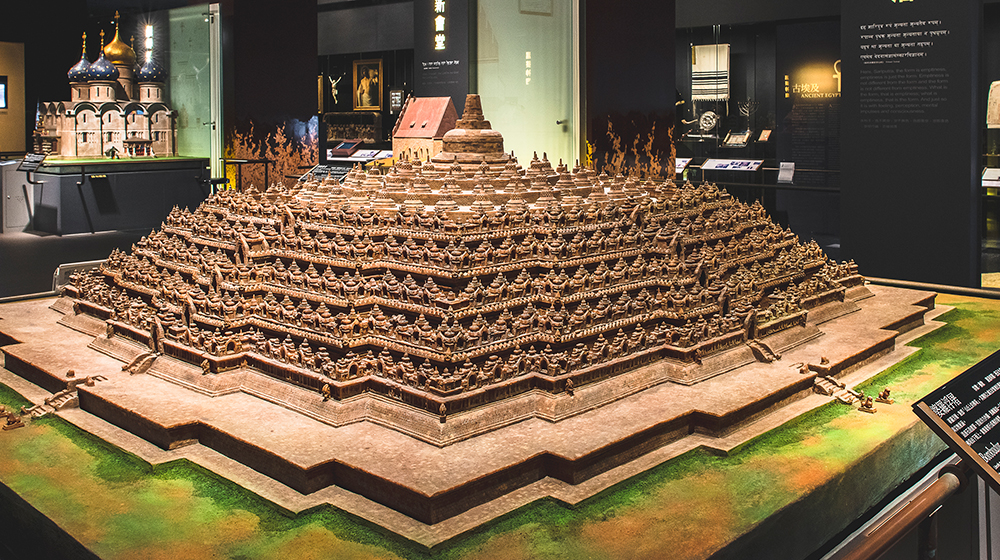
Assumption Cathedral (Trinity St. Sergius Monastery)
Religion: Christianity
Period of Construction: 15th to 18th century C.E.
Location: Zagorsk, Russia
Model Scale: 1:30
Trinity St. Sergius Monastery is located in the small town of Sergiev Posad, on the outskirts of Moscow. The Monastery was founded by the Russian saint Sergius. Due to the control of the Church and many wars, Holy Trinity Monastery consists of a church complex and a military fortress with a collection of ancient historical materials and artifacts. The Assumption of the Blessed Virgin Mary is the largest and most important of these buildings.
The walls are made of pure white limestone, and the roof is a blue and gold star roof in Byzantine style and decorated with icons inside the building. This monastery is an outstanding example of Russian church architecture.
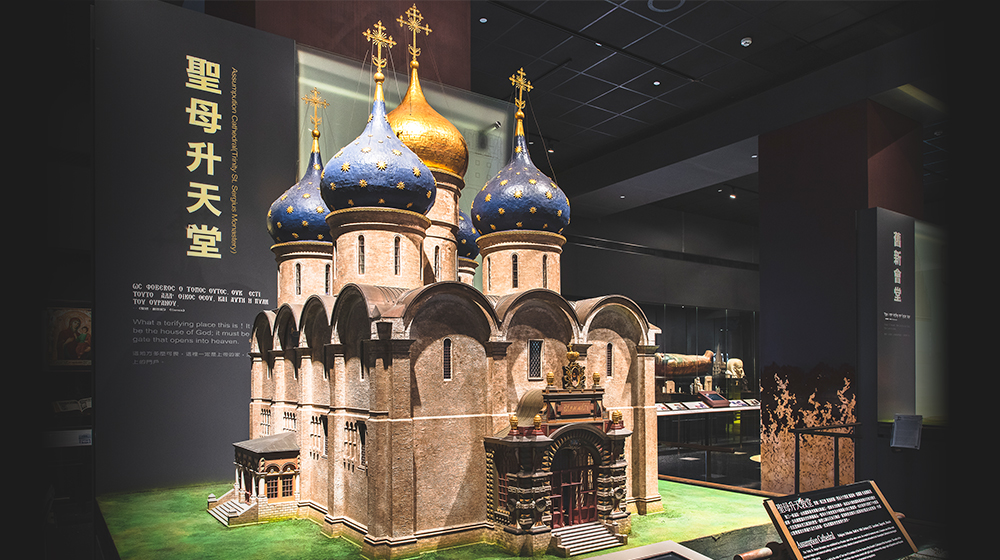
Altneuschl (Old-New Synagogue)
Religion: Judaism
Period of Construction: 13th century C.E.
Location: Prague, Czech Republic
Model Scale: 1:30
Trinity St. Sergius Monastery is located in the small town of Sergiev Posad, on the outskirts of Moscow. The Monastery was founded by the Russian saint Sergius. Due to the control of the Church and many wars, Holy Trinity Monastery consists of a church complex and a military fortress with a collection of ancient historical materials and artifacts. The Assumption of the Blessed Virgin Mary is the largest and most important of these buildings.
The walls are made of pure white limestone, and the roof is a blue and gold star roof in Byzantine style and decorated with icons inside the building. This monastery is an outstanding example of Russian church architecture.
